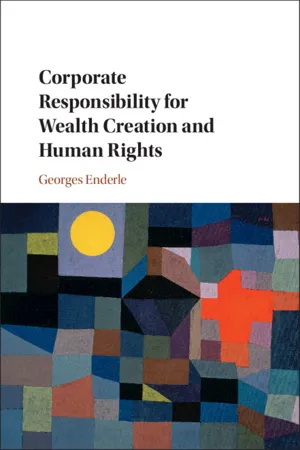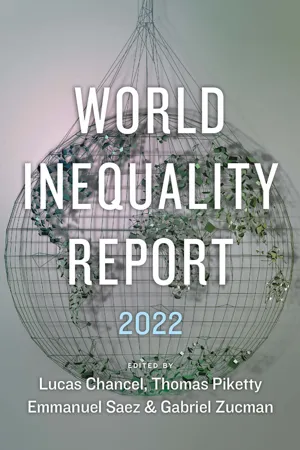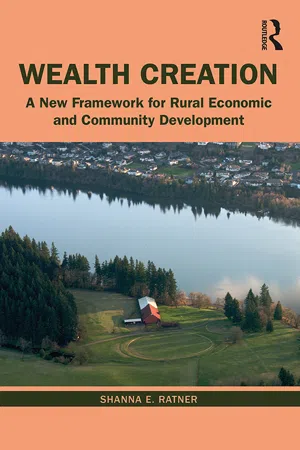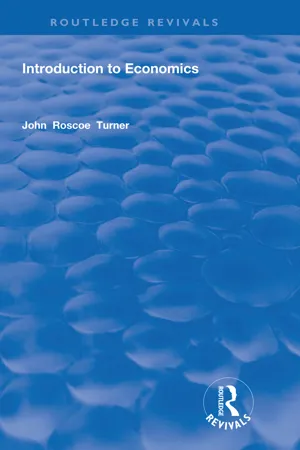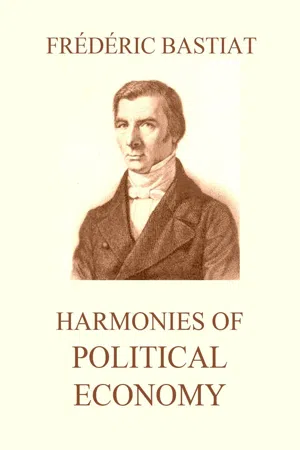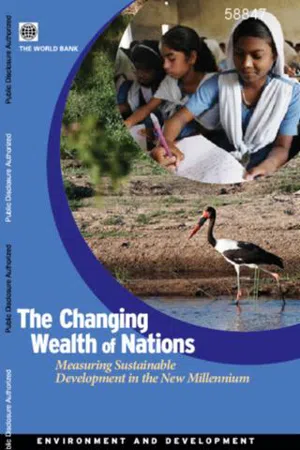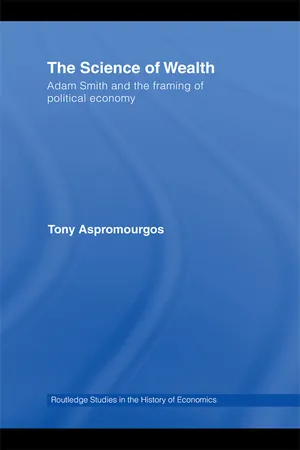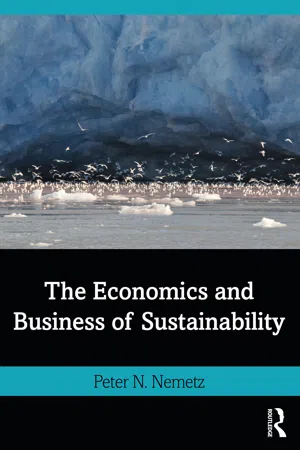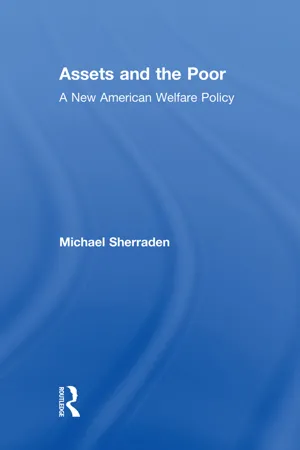Economics
Wealth
Wealth refers to the abundance of valuable resources or assets that can be used to generate income or provide economic security. In economics, wealth encompasses a wide range of assets including money, property, investments, and physical possessions. It is a key factor in determining an individual's or a nation's economic well-being and standard of living.
Written by Perlego with AI-assistance
Related key terms
1 of 5
10 Key excerpts on "Wealth"
- Georges Enderle(Author)
- 2021(Publication Date)
- Cambridge University Press(Publisher)
part i Wealth Creation The Purpose of Business and the Economy 3 | Semantics and the Wealth of Nations A Brief Semantic Exploration Wealth can have many different meanings. In colloquial language it can mean a huge amount of money or a plenitude of material things. Merriam Webster’s Collegiate Dictionary (2003) defines Wealth as an abundance of valuable material possessions or resources, abundant supply, property that has a monetary value or an exchange value, or material objects that have economic utility, especially the stock of useful goods having economic value in existence at any one time (as in “national Wealth”). Because Wealth often has a connotation of extreme riches, one tends to avoid this ostentatious word and prefers to speak of “prosperity.” But Wealth can also have a figurative sense, as in the Wealth of data (available, for instance, at the World Bank), the Wealth of new ideas, the Wealth of good health or “the immeasurable riches [πλουτος] of his grace” (as Paul writes of God to the Ephesians in chapter 2:7). As Robert Heilbroner states (1987, 880), “Wealth is a fundamental concept in economics indeed, perhaps the conceptual starting point for the discipline. Despite its centrality, however, the concept of Wealth has never been a matter of general consensus.” As for the term itself, it figures prominently in Adam Smith’s book An Inquiry into the Nature and Causes of the Wealth of Nations (1776), but is conspicuously absent from Gunnar Myrdal’s book Asian Drama: An Inquiry into the Poverty of Nations (1968). It is complemented with its opposite in David Landes’s book The Wealth and Poverty of Nations: Why Some Are So Rich and Some So Poor (1999), following Malthus’s quote in his letter of January 26, 1817 to Ricardo: “. . . the causes of the Wealth and poverty of nations – the grand object of all enquiries in Political Economy” (Keynes 1933/1972, 97–98; Landes 1999, vii).- eBook - PDF
- Lucas Chancel, Thomas Piketty, Emmanuel Saez, Gabriel Zucman, Lucas Chancel, Thomas Piketty, Emmanuel Saez, Gabriel Zucman(Authors)
- 2022(Publication Date)
- Belknap Press(Publisher)
Capital can be accumulated in many forms: residences and buildings, equipment and machinery, intangible capital such as software. Price effects reflect the dynamics of market perceptions of various types of assets. The value of a house might increase or decrease without any improvements being made by its owners, simply because there is a shortage of housing in the area. 1 In national accounts, Wealth can take either of two forms: financial or non-financial assets. Financial assets are contractual financial claims such as bank deposits, stocks, bonds and equities. Non- financial assets, by contrast, refer to assets such as land, housing, machinery and intangibles, which typically derive their value from their direct physical or immaterial properties. When studying Wealth, it is always important also to think about financial liabilities, i.e. debts: the net Wealth of a country or an individual is always the sum of their financial and non-financial assets, minus their debts (see Box 3.1). Two types of actors can own Wealth: private actors and public actors. By definition, the Wealth of a country is equal to the sum of net private Wealth and net public Wealth. Private actors are individuals who own firms, bonds, housing, etc. in their own names, and private foundations and institutions such as religious organizations, which can also own assets and liabilities. 2 Public actors are local and central governments around the world. Their assets can take many forms: public hospitals and roads, as well as bonds and publicly owned firms, for instance. And what about the corporate sector, that is firms? Firms can indeed own capital, and other firms (and the assets of these firms) but ultimately, a private or a public actor has to own these firms. - eBook - ePub
Wealth Creation
A New Framework for Rural Economic and Community Development
- Shanna E. Ratner(Author)
- 2019(Publication Date)
- Routledge(Publisher)
2 What is Wealth? When we hear the world “Wealth” in the United States, most of us think of financial assets. But Wealth is a lot more than financial assets, and financial assets alone cannot sustain us. After all, money isn’t tasty or nutritious and research has established that money alone can’t make you happy. Financial assets become productive when they are invested in other forms of Wealth that together create resilient households and communities and a truly sustainable economy with widely shared benefits. If money alone isn’t the answer, what is? What are the other forms of Wealth that create the foundation for a truly sustainable economy? We include eight forms of Wealth in the WealthWorks framework. They are only “Wealth” to the extent that they are fully productive and can contribute to meeting current needs while remaining capable of meeting future needs as well. If they are degraded and not fully functional and they require investment to restore functionality, they are not “Wealth,” they either are or are on the way to becoming liabilities. The concepts behind these forms of Wealth are not original to WealthWorks; in fact each form of Wealth has its own origin story briefly described below. Economists have been attempting to redefine Wealth as more than financial capital since at least the turn of the 21st century, using terms like “inclusive Wealth,” 1 “genuine Wealth,” 2 and “intangible capital”. 3 The community capitals framework, familiar to many community developers, is comprised of seven forms of capital and was first introduced by Cornelia and Jan Flora in 2004 as a means to focus on rural community assets rather than deficits. 4 The Floras’ work has been instrumental in taking these concepts beyond academia and into communities. In general, there is no widely shared cross-disciplinary agreement on the precise definitions of many non-financial forms of Wealth - eBook - ePub
- John Roscoe Turner(Author)
- 2019(Publication Date)
- Taylor & Francis(Publisher)
limited Wealth almost wholly to capacity. Lord Lauderdale (an English economist of the last century) furnished us with the noteworthy example of a privately owned supply of water. Water was so scarce and so valuable that a good well was a private fortune. Improvements were made which furnished such a supply of good water as to make the privately owned well valueless. There the creation of social Wealth was the destruction of private Wealth. The American economists—Daniel Raymond, A. H. Everett, Willard Phillips and less noteworthy writers of a century ago —defined Wealth as "national capacity." They would not limit Wealth to objects of private property which are bought, sold, and exchanged. They taught that national productive capacity (Wealth) must include the free as well as the slave, a salubrious atmosphere, and a navigable river without tolls as well as a canal with tolls. They agreed with the English economists, Lord Lauderdale and David Ricardo, who reasoned that if water should become scarce and high-priced, the individual owners of it would be richer, but society as a whole would be poorer. They would have argued that a deeper channel for the Mississippi River would be as truly an object of Wealth as is an artificial levee costing many millions of dollars. They would have argued that had Providence constructed a broadflowing and navigable river from Colon to Panama It would have been an object of Wealth as truly as is a man-made canal costing upwards of three hundred and fifty millions.Economic writings fall largely into two groups: One emphasizes social Wealth In the broad sense of productive capacity; the other emphasizes Wealth in the restricted sense of things owned. The early American economists emphasized the former, while the majority of recent American economists emphasize the latter. The present work recognizes the twofold aspect of Wealth. Neither aspect must be overlooked, nor must they be confused.7. Wealth Not a Comparative Concept.Another misconception to be avoided is to consider Wealth as a comparative term. The word Wealth is derived from the word weal (from the same root as well ), which means a prosperous state of being. Later usage caused Wealth to be applied to the things which produce a prosperous state. In this sense it was used comparatively to indicate "that abundance of worldly estate which exceeds the estate of the greater part of the community." We now use the adjective rich in this sense. It is proper to use the word rich in a comparative sense; it is proper to say that the rich man has more Wealth than others or that he has more purchasing power than others. The word rich - eBook - ePub
- Frédéric Bastiat(Author)
- 2017(Publication Date)
- Jazzybee Verlag(Publisher)
VI. Wealth.One of the greatest difficulties, one of the most fertile sources of misunderstanding, controversy, and error, here presents itself to us at the very threshold of the science—We have seen that in every commodity which is adapted to satisfy our wants and desires, there are two things to be considered and distinguished: what nature does, and what man does,—what is gratuitous, and what is onerous—the gift of God and the service of man—utility and value. In the same commodity the one may be immense, and the other imperceptible. The former remaining invariable, the latter may be indefinitely diminished; and is diminished, in fact, as often as an ingenious process or invention enables us to obtain the same result with less effort.What is Wealth?Are we rich in proportion to the utilities which we have at our disposal,—that is, in proportion to the wants and desires which we have the means of satisfying? “A man is rich or poor,” says Adam Smith, “according as he possesses a greater or smaller amount of useful commodities which minister to his enjoyments.”Are we rich in proportion to the values which we possess,—that is to say, the services which we can command? “Wealth,” says J. B. Say, “is in proportion to Value. It is great if the sum of the value of which it is composed is great—it is small if the value be small.”The vulgar employ the word Wealth in two senses. Sometimes we hear them say—“The abundance of water is Wealth to such a country.” In this case, they are thinking only of utility. But when one wishes to reckon up his own Wealth, he makes what is called an Inventory, in which only commercial Value is taken into account.With deference to the savants, I believe that the vulgar are right for once. Wealth is either actual or relative. In the first point of view, we judge of it by our satisfactions. Mankind become richer in proportion as they acquire a greater amount of ease or material prosperity, whatever be the commodities by which it is procured. But do you wish to know what proportional share each man has in the general prosperity; in other words, his relative Wealth - eBook - PDF
The Changing Wealth of Nations
Measuring Sustainable Development in the New Millennium
- World Bank(Author)
- 2011(Publication Date)
- World Bank(Publisher)
In addition, economic sustainability is not the same as human well-being. Although the value of comprehensive Wealth may be similar for countries, the well-being of citizens may be quite different, due to factors such as cultural capital that cannot be incorporated in economic values. A major review of current measures of economic performance such as GDP by Stiglitz, Sen, and Fitoussi (2009) discusses these issues; despite the limitations, the report recommends comprehensive Wealth as one useful indicator of economic performance. 24 THE CHANGING Wealth OF NATIONS Notes 1 Strictly speaking, social welfare is equal to the present discounted value of current and future well-being. The link between change in real, comprehensive Wealth and change in social welfare has been established in a large body of theoretical work by such authors as Hamilton and Clemens (1999), Dasgupta and Mäler (2000), and Asheim and Weitzman (2001). The theory has been tested empirically by Ferreira and Vincent (2005) and Ferreira, Hamilton, and Vincent (2008). 2 Note, however, that the SNA measure of Wealth is much narrower than what is presented here, because the asset boundary includes only produced assets and natural assets that are subject to property rights. The expansion of the asset boundary for natural capital is discussed in the Handbook of National Accounting: Integrated Environmental and Economic Accounting, which is currently undergoing revision (United Nations et al. 2003). 3 Net financial assets are not available for all countries. The information assists in the analysis of intangible capital in chapter 5 and is reported in the appendixes. 4 Note that urban land is estimated as a simple markup of the value of produced capital. It is generally reported as part of produced capital in the aggregates presented in this book. 5 Throughout the book, all Wealth figures are reported in constant 2005 U.S. - eBook - ePub
The Science of Wealth
Adam Smith and the framing of political economy
- Tony Aspromourgos(Author)
- 2008(Publication Date)
- Taylor & Francis(Publisher)
It is being utilized to signify whatever particular and varying worthy thing, or things, that humans, or thinkers, or national policies choose to pursue, so that the proposition that analysis or policy should pursue ‘Wealth’ is hardly more than a tautology. The issue of substance then is the change or difference in things aimed for. Hence, for example, Tribe (1984: 273) points out that in the German cameralist framework ‘a primary form of Wealth for a ruler consisted in the good order of his subject population’. And in the broadest historical terms, one can conclude, in a rough and ready way, that it is as if the content given to Wealth-as-well-being narrows to a materialist conception. Put bluntly, the modern resolution of ‘Wealth’ is that well-being is material. One might be tempted, from a twenty-first century vantage point (at least if the view is from within a developed social economy), to take the high moral ground with respect to this kind of materialism. Scepticism concerning material accumulation has latterly been increasingly encouraged: on the one hand, by a sense that in at least some respects individual consumption has reached the neighbourhood of what may be regarded as satiation; on the other, by a widening consensus that the depletion of non-renewable natural resources associated with that human material accumulation is unsustainable, if not a serious threat to human well-being into the future (on the latter, see Chapter 4, n. 31). (Who can say for sure that Smith, come back from the dead more than two centuries on, would not share these views, if it is at all sensible to pose such an unhistorical question?) However, any such moral scepticism with regard to contemporary material aspirations and their ecological or environmental consequences also should be tempered by historical sensitivity with regard to eighteenth-century aspirations - eBook - PDF
The Changing Wealth of Nations 2018
Building a Sustainable Future
- Glenn-Marie Lange, Quentin Wodon, Kevin Carey(Authors)
- 2018(Publication Date)
- World Bank(Publisher)
THE CHANGING Wealth OF NATIONS 2018 26 health and potential for future growth. This is especially clear for resource-rich countries, which could deplete their natural resources for short-term gains—increasing GDP per capita at the expense of long-term sustain-ability and future growth. To assess a country’s economic health, measures of annual economic activity such as GDP per capita need to be complemented with measures of the country’s asset base or Wealth, noting that the asset base of coun-tries is what enables them to generate future income. This volume, the third in a series of studies on the Wealth of nations published by the World Bank, provides new measures of the changing Wealth of nations and illustrates how these measures can inform policy. A key innovation in this volume is the estimation of countries’ human capital Wealth using household surveys for 141 countries. A separate companion volume looks in more detail at human capital Wealth accounts and their use for policy (Wodon, forthcoming). Wealth accounts are an integral part of the System of National Accounts (SNA) (EC et al. 2009). The SNA provides the basis for mea-suring national economic progress by governments, the private sector, international organizations, and many other stakeholders around the world. However, Wealth accounts are not nearly as widely implemented as the measures of annual production and income, such as GDP. This might appear somewhat puzzling, since standard business accounting systems developed for the private sector include both an income state-ment (revenues, costs, and so on), as well as a balance sheet (assets and liabilities). 1 National Wealth accounts have not yet been widely implemented by countries for two main reasons. First, the focus of the SNA and statistical offices on national production and income is largely the result of histori-cal conditions. - eBook - ePub
- Peter N. Nemetz(Author)
- 2021(Publication Date)
- Routledge(Publisher)
In sum, it is clear that the sustainability challenges we face today – economic, social and ecological – are the result of the long period of global economic growth, and continuation of this trend poses even greater challenges. As such, it is essential to understand the evolution of modern economic theory designed to address these issues. The next three chapters describe the origins, development and principal components of the subfield of environmental economics, and the following three chapters outline the basic principles of ecology and the relatively new discipline of ecological economics.Appendix 4.1The World Bank’s calculation of total Wealth (World Bank 2011, pp. 142–143, reproduced with permission)Total Wealth
Total Wealth can be calculated asW t =; where Wt is the total value of Wealth, or capital, in year t; C(s) is consumption in year s; and r is the social rate of return to investment. The social rate of return from investment is equal to:∫ t ∞C ( s ) ×ed s− r ( s − t )r=ρ+ηC Cwhere r is the pure rate of time preference, h is the elasticity of utility with respect to consumption. Under the assumption that h = 1, and that consumption grows at a constant rate, then total Wealth can be expressed as:(A.1)W t =∫ t ∞C ( t ) ×ed s− r ( s − t )The current value of total Wealth at time t is a function of the consumption at time t and the pure rate of time preference.Expression (A.1) implicitly assumes that consumption is on a sustainable path, that is, the level of saving is enough to offset the depletion of natural resources. The calculation of total Wealth requires that two issues be considered in computing the initial level of consumption:- The volatility of consumption. To solve this problem we used the five-year centered average of consumption for each of the three years: 1995, 2000 and 2005.
- Negative rates of adjusted net saving
- eBook - ePub
Assets and the Poor
New American Welfare Policy
- Michael Sherraden, Neil Gilbert(Authors)
- 2016(Publication Date)
- Routledge(Publisher)
American Economic Review 8, 1968, 1315–19; and Marilyn Moon, The Measurement of Economic Welfare. New York: Academic Press, 1977. The standard treatment of assets in these formulations is as a storehouse of potential consumption. Among welfare policy analysts, assets have not been viewed as having welfare effects other than consumption.28. Susan Mayer and Christopher Jencks, “Poverty and the Distribution of Material Hardship,” Journal of Human Resources 24(1), 1989, 88–114.29. Edward N. Wolff, “Wealth Holdings and Poverty Status in the U.S.,” Review of Income and Wealth, 1990 (in press at this writing, based on a paper presented at the 20th General Conference of the International Association for Research on Income and Wealth, in Roca di Papa, Italy, August 1987).30. Daniel Radner, “Assessing the Economic Status of the Aged and Nonaged Using Alternative Income-Wealth Measures,” Social Security Bulletin 53(3), 1990, 2–14.31. James Kearl, Clayne Pope, and Larry Wimmer, “The Distribution of Wealth in a Settlement Economy: Utah, 1850–1870,” Journal of Economic History 40, 1980, 477–96.32. Simon Kuznets, “Economic Growth and Income Inequality,” American Economic Review 45, 1955, 1–28.33. M.S. Ahluwalia, “Income Inequality—Some Dimensions of the Problem,” in H. Chenery et al., Redistribution with Growth. London: Oxford University Press, 1976, 3–37.34. John Angle, “The Surplus Theory of Social Stratification and the Size Distribution of Personal Wealth,” Social Forces 65, 1986, 293–326; and Robert Lampman, The Share of Top Wealth-Holders in National Wealth, 1922–1956. Princeton, NJ: Princeton University Press, 1962.35. Gerhard Lenski, Power and Privilege: A Theory of Social Stratification. New York: McGraw-Hill, 1966.36. Piven and Cloward, 1982.37. Edward N. Wolff, ed., International Comparisons of the Distribution of Household Wealth.
Index pages curate the most relevant extracts from our library of academic textbooks. They’ve been created using an in-house natural language model (NLM), each adding context and meaning to key research topics.
